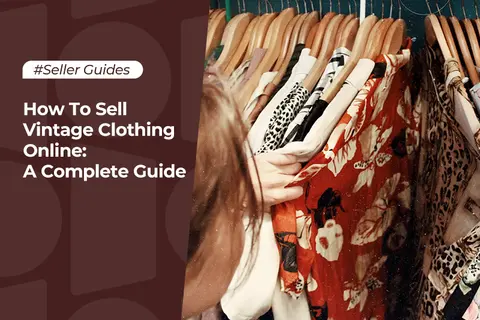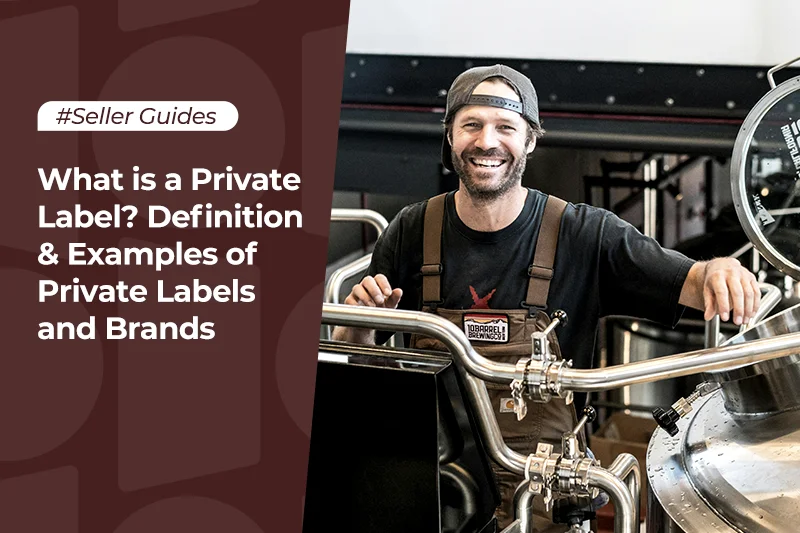How To Sell Vintage Clothing Online: A Complete Guide

Table of Contents
Do you adore vintage clothes? Well, you might just be the right fit for selling vintage clothing online.While fast fashion rules the fashion world today, vintage clothes bring something special: quality and personality that’s rare in modern attire.
Your vintage collection could fulfill this need, offering an eco-friendly choice that exudes uniqueness and timeless flair.This guide will help you channel your love for vintage fashion, and teach you how to sell vintage clothing online.
What Is the Vintage Clothing Market?
The vintage clothing market has boomed in recent years, drawing more and more people to its unique allure and classic style.One big reason for this is the growing concern for sustainable fashion. With folks becoming more aware of the environmental impact of fast fashion, they're turning to vintage clothes as a greener choice.
Another reason for vintage clothing's popularity is the nostalgia it brings. Vintage clothes often remind folks of times past, stirring up feelings of nostalgia and sentimentality. Wearing a vintage piece can take you back in time, letting you relive past fashion trends and cultural moments.
When it comes to finding vintage clothes, there are plenty of places to look. Thrift stores, flea markets, estate sales, and online platforms all offer opportunities to discover unique vintage pieces.
In conclusion, the vintage clothing market is thriving, thanks to sustainability, nostalgia, and individuality. Knowing the difference between vintage and antique, finding authentic pieces, and using effective marketing strategies are all essential for success in this field. By embracing the timeless appeal of vintage clothing, you can sell your own vintage clothes in the market.
Why Sell Vintage Clothing Online?
In recent years, there's been a noticeable shift in consumer behavior, especially among Millennials and Gen Z. They're becoming increasingly aware of the impact of their purchases and are seeking out affordable and eco-friendly clothing choices through online shopping. This trend has propelled the popularity of shopping for vintage clothing into the mainstream, resulting in a significant surge in sales and market expansion.
For example, many young shoppers are now opting to buy vintage denim jeans instead of brand-new ones. They appreciate the unique style and quality of vintage denim, while also contributing to reducing the environmental footprint associated with producing new jeans.
Additionally, vintage t-shirts with retro designs have become a trendy fashion statement among younger generations. Instead of purchasing newly manufactured graphic tees, they're choosing vintage ones for their authenticity and sustainability.
This shift in consumer preferences towards vintage clothing reflects a broader movement towards conscious consumption and sustainable fashion choices.
Benefits and Difficulties of Selling Vintage Clothing Online
The benefits of selling vintage online
Selling vintage clothing online offers a big plus: you can usually find lots of clothes at low prices. But there's a challenge too – it takes time to find the right stuff for there are more than one e-commerce company. And once you've got it, there's work to do. You need to check, clean, and fix up the clothes. People still want good quality, even if it's second-hand. Then, you've got to take nice pictures of the clothes and store them properly before selling.
Let's say you find a bunch of vintage dresses at a thrift store for a steal. You'd need to carefully inspect each one, mend any loose seams or buttons, and wash them gently to get them looking their best before showcasing them online. Once they're picture-perfect, you can snap some flattering photos and list them on your online store.
The difficulties of selling vintage online
Apart from the specific benefits and challenges related to individual items, online retailing in general offers its own set of opportunities and obstacles.
Thanks to existing platforms and handy tools, starting to sell vintage clothing online is quick and relatively easy. You have the flexibility to determine the scale of your online presence, the amount of time and money you want to invest, and where you want to operate from.
However, in the vast landscape of online retail, making the most of these opportunities and standing out from the competition can be tough. Plus, there's the matter of shipping logistics to consider. Since customers can't physically examine or try on clothing before buying, you'll need a solid plan for handling shipping and managing returns. One option is to collaborate with a dropshipping provider, who handles storage and shipping for you.
How to Sell Vintage Clothing Online?
1. Choose a niche
Vintage clothing is super trendy, but with lots of competition, you need a special angle to shine. Selling a little bit of everything won’t do the trick. To really make your mark, think about carving out a niche for your business.
-
Concentrate on specific time periods.
-
Specialize in particular types of clothing.
-
Offer vintage clothing collections from different decades.
-
Focus on specific occasions like vintage evening wear or sports gear.
2. Find vintage clothes to sell
When stocking up for your vintage clothing business, thrift shops are your go-to spot. Make it a habit to drop by regularly to snag new arrivals. Before you go, figure out what you're hunting for—whether it's specific styles or time period by some best websites to buy clothes.
Here are a few key questions to consider when diving into the world of vintage clothing:
-
Who's your target audience? Are you aiming for young hipsters, vintage enthusiasts, or perhaps eco-conscious shoppers?
-
How do you want your brand to stand out? Think about your brand identity—like your name, logo, colors, and photography style. For example, if you're all about funky 70s vibes, your branding should reflect that.
-
What's your brand voice? Are you casual and friendly, or more formal and professional? Your tone should resonate with your target audience and align with your brand image. For instance, if you're targeting Gen Z, your brand voice might be fun and quirky, while if you're appealing to vintage purists, it might be more nostalgic and refined.
3. Establish your own vintage clothing brand
Having a strong brand is super important in the online world. Craft a story that really connects with your target customers. Use your website design, logo, and marketing stuff to show off what your brand is all about. This helps people trust and remember you.
Starting your vintage brand means having a clear idea of what you're all about. Think about your brand story. What makes your collection special? Choose a name and logo that capture this vibe. And make sure your colors and fonts match the vintage feel too.
Know who your customers are. Make sure everything—from your website to your social media—matches their style. Being consistent across all your platforms is key. It helps folks recognize and remember you.
4. Set up your online vintage clothing store
Before diving into the details of setting up your store, it's crucial to consider where you'll be selling your vintage clothing online. Will you opt for an e-commerce platform like Shopify, or does listing your products on a marketplace such as Etsy, eBay, or Vinted seem like a better fit for your business?
Setting up your vintage clothing store is simpler than you might imagine. Beginning with a platform like Shopify allows you to experiment and try things out without any pressure. It's a gentle push to prepare your inventory and kickstart your business journey.
Imagine you're starting your vintage clothing business on Etsy. You'd spend some time exploring the platform, setting up your shop, and uploading your first few items to see how it all works. It's a low-risk way to dip your toes into the world of online retail.
5. Formulate a marketing plan for your online vintage clothing store
You might have the coolest vintage finds ever, but if folks don't know about them, they can't buy them. Here's how to get your vintage store noticed:
-
Get Social: Use platforms like Instagram and Facebook to showcase your awesome vintage pieces. Share pictures of your latest arrivals, behind-the-scenes snaps, and style inspiration. For example, post a pic of a customer rocking one of your vintage dresses and tag your store. It's a great way to reach new customers and show off your unique style.
-
Stay Connected: Keep your customers in the loop by sending out regular newsletters or emails. Let them know about upcoming sales, new arrivals, or special events. For instance, send out a monthly newsletter with highlights from your latest collection and exclusive discounts for subscribers. It helps keep your brand top of mind and encourages repeat business.
-
Amp Up Your Online Game: Make sure your website is easy to navigate and looks professional. Use high-quality images and clear product descriptions to showcase your vintage pieces. For example, if you specialize in vintage denim, create a dedicated section on your website with detailed descriptions and photos of each pair of jeans. It helps customers find what they're looking for and boosts your credibility as a seller.
-
Build Relationships: Focus on building long-term relationships with your customers. Offer personalized recommendations based on their preferences, send handwritten thank-you notes with their orders, or host exclusive events for loyal customers. For example, offer a special discount code to customers who have made multiple purchases or invite them to a VIP shopping event. It shows that you value their business and encourages them to keep coming back.
Conclusion
To succeed in selling vintage clothing online, you've gotta have a passion for fashion and a good eye. Scouring flea markets, thrift stores, and even friends' closets for the perfect pieces takes time. And getting those clothes ready for sale—cleaning them up and taking great photos—can be a whole job in itself.
But the real magic happens when you actually sell the clothes. It takes creativity and patience to craft listings that catch people's eye. Pictures that show off the clothes well and descriptions that tell a story can make all the difference.
Luckily, with the right tools and know-how, you can set up the technical side of your online vintage shop. That way, you can focus on finding those killer pieces and making sure they find a new home.
Start your borderless business here
Tell us about your business and stay connected.
Keep up with the latest from Alibaba.com?
Subscribe to us, get free e-commerce tips, inspiration, and resources delivered directly to your inbox.















